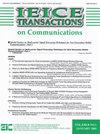Efficient Data Diffusion and Elimination Control Method for Spatio-Temporal Data Retention System
IF 0.6
4区 计算机科学
Q4 ENGINEERING, ELECTRICAL & ELECTRONIC
引用次数: 0
Abstract
With the development and spread of Internet of Things technologies, various types of data for IoT applications can be generated anywhere and at any time. Among such data, there are data that depend heavily on generation time and location. We define these data as spatiotemporal data (STD). In previous studies, we proposed a STD retention system using vehicular networks to achieve the “Local production and consumption of STD” paradigm. The system can quickly provide STD for users within a specific location by retaining the STD within the area. However, this system does not take into account that each type of STD has different requirements for STD retention. In particular, the lifetime of STD and the diffusion time to the entire area directly influence the performance of STD retention. Therefore, we propose an efficient diffusion and elimination control method for retention based on the requirements of STD. The results of simulation evaluation demonstrated that the proposed method can satisfy the requirements of STD, while maintaining a high coverage rate in the area. key words: STD, data retention, diffusion and elimination, dynamic transmission interval control时空数据保留系统中有效的数据扩散与消除控制方法
随着物联网技术的发展和普及,物联网应用的各类数据可以随时随地生成。在这些数据中,有一些数据严重依赖于生成时间和位置。我们将这些数据定义为时空数据(STD)。在以往的研究中,我们提出了一种使用车辆网络的STD保留系统,以实现“STD的本地生产和消费”范式。该系统可以通过保留该区域内的STD,快速为特定位置的用户提供STD。然而,这个系统没有考虑到每种类型的性病对性病的保留有不同的要求。特别是STD的寿命和扩散到整个区域的时间直接影响STD的保留性能。因此,我们提出了一种基于STD要求的有效的滞留扩散和消除控制方法,仿真评估结果表明,该方法能够满足STD要求,同时在该区域保持较高的覆盖率。关键词:STD,数据保留,扩散和消除,动态传输间隔控制
本文章由计算机程序翻译,如有差异,请以英文原文为准。
求助全文
约1分钟内获得全文
求助全文
来源期刊

IEICE Transactions on Communications
工程技术-电信学
CiteScore
1.40
自引率
28.60%
发文量
101
审稿时长
3.7 months
期刊介绍:
The IEICE Transactions on Communications is an all-electronic journal published occasionally by the Institute of Electronics, Information and Communication Engineers (IEICE) and edited by the Communications Society in IEICE. The IEICE Transactions on Communications publishes original, peer-reviewed papers that embrace the entire field of communications, including:
- Fundamental Theories for Communications
- Energy in Electronics Communications
- Transmission Systems and Transmission Equipment for Communications
- Optical Fiber for Communications
- Fiber-Optic Transmission for Communications
- Network System
- Network
- Internet
- Network Management/Operation
- Antennas and Propagation
- Electromagnetic Compatibility (EMC)
- Wireless Communication Technologies
- Terrestrial Wireless Communication/Broadcasting Technologies
- Satellite Communications
- Sensing
- Navigation, Guidance and Control Systems
- Space Utilization Systems for Communications
- Multimedia Systems for Communication
 求助内容:
求助内容: 应助结果提醒方式:
应助结果提醒方式:


